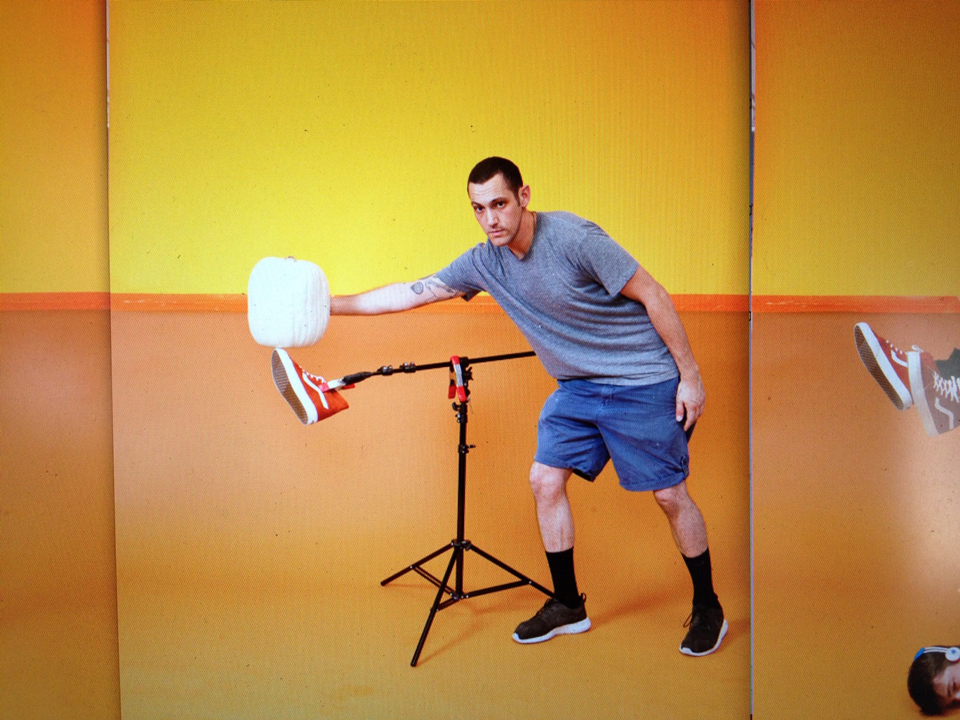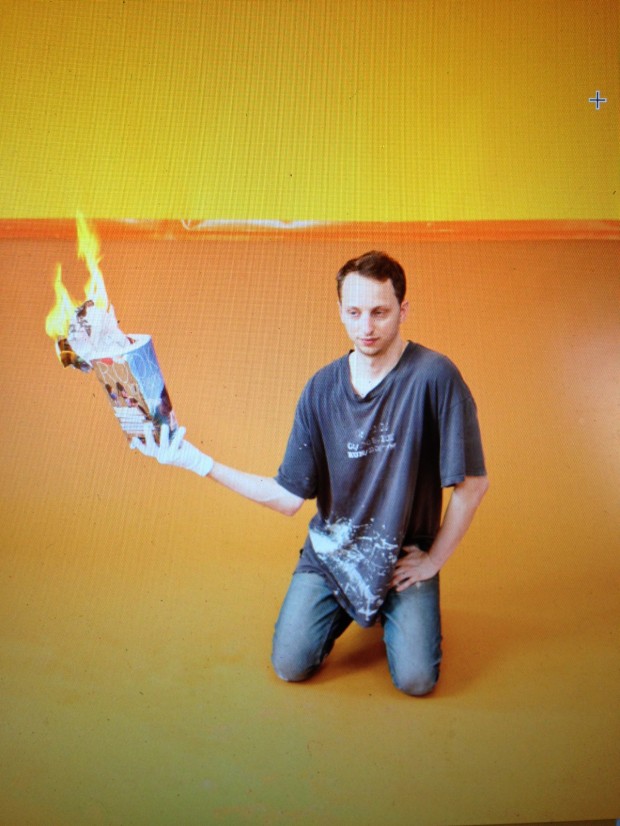Artist Alex Da Corte talks the politics of shopping and the mischief of pop
See Alex Da Corte's Essentials page:FADER ISSUE 88
If you have ever been to a supermarket, you know the value of really great merchandising—towers of cans, mounds of fresh produce covered in beads of dew. Philadelphia-based artist Alex Da Corte makes work about the circumstances that lead to a beautifully considered sales display, from the person who made it to the history of the materials. He considers himself an anthropologist of the immediate past, and looks for meaning in the stuff that fills our stores and later our trash dumps by repurposing it, re-displaying it and showing its less camera-ready angles. For our recent Trent Reznor Icon issue, we asked Da Corte to re-imagine our style Essentials page, where we highlight clothing and products we think will be crucial to our readers in the coming months. In other words, we asked him to create his own version of a product display. One sub-theme of that issue was the suburbs, and the arrangement he came up with really nailed the mood of a place where things are not exactly as they appear. The anatomical impossibility of the dancer’s pose, the pumpkin (is it ceramic?) balanced perfectly on his toe, and even the book on fire seem to embody the threats that can lurk beneath a perfectly manicured surface. We talked to Da Corte about some of the thinking that went into that piece, the politics of shopping and the mischief of pop.
What is your relationship to commerce and commercial modes of display? The way objects and images are shared in retail spaces and cultural venues in the real world and online, they are constantly speaking to each other in way that correlates to the economic or political state. I like to assess what’s happening in kind of an anthropological way. To examine these artifacts culture is creating before they gather too much dust or get buried in our past, and try to reconsider them in the moment they’re being considered.
How does that play out in your day to day? Do you go to a Walmart and just walk around? I go to supermarkets quite a bit. I look at how things are packaged or how people shop and what kind of socks they’re wearing, thinking about who the consumer is. Like going to a supermarket or the mall, or going to the bank or the park or a movie theatre, and seeing how people are absorbing objects and information, and what kind of information. I like to understand that I’m a participant and that we’re all always participants.
Would you say that necessitates ridding yourself of any irony or remove before interacting with these objects? Yeah, I’m not interested in irony at all, [albeit] maybe in the sense of understanding that it is a part of our vocabulary and that it is a tool we use. I try to actively participate and push against my own tastes all the time, do things I may say I wouldn’t do or that I wouldn’t think of doing, so I can be a platform to experience a lot of things.
So would you say that you have no personal taste? Well, of course I have personal taste, but when it comes to buying and collaging, I’m trying to undo the personal, whatever that is—any preconceived idea of a thing or experience. I’m trying to push into a territory that is under-explored within my own psyche, and in doing so, I get to be outside of myself, see things in ways that I maybe didn’t know existed.
What sort of objects do you find yourself looking for these days when you go shopping? I’m in interested in things like buying two hundred bottles of Cool Metal Axe body wash at a grocery store, and no one batting an eye. And I’m interested in how someone arranges objects in a really particular way on a shelf when I go to a particular thrift store in Philly—that‘s someone who’s not interested in art, but who’s interested in form and color or has an interest in arranging things in a way that’s pleasing to them. Or I notice how somebody cuffs his or her pants or how someone picks out a certain bottle or uses a certain phrase. I’m looking at the way people move through space, and then I’m highlighting those things when I make [my work]—not in the way I would do it, but in the way so and so on the street would do it. I’m like the flaneur; in that way I mean I have no taste. The taste is sort of like their taste and their taste is my taste. Everybody’s taste is shaped by something.

Above: Alex Da Corte on set.
Would you say it's a process of carving out the space to reconsider this type of image or object more deeply? Objects have a cultural history that speaks to race or class, gender and politics, and that’s something that’s overlooked quite a bit. Images are what they are, and they last in our mind for several seconds, and we don’t consider history. So much of my work is about historicizing things and understanding them in terms of time and space, understanding that they do exist in the physical world, although we might not look up from our phones. To consider where things come from is an important thing and in some ways it becomes a radical thing.
What are your thoughts on doing a commercial project like this for The FADER, where your work becomes a literal product display? It’s just different hats, and it’s interesting to put them on for some time. For me, doing a shoot for The FADER is like Lars von Trier making a film about America. It’s not something that I experience in my day-to-day, but I’m interested in how those things operate from the outside looking in. You can speak to the perversion of image, and reconsider it in a [Marcel] Duchamp kind of way, like in a gallery or museum [context]. In a more commercial advertising platform, it’s not the same audience, but I think there’s room to propose those things again, and say, “Consider this. How strange?” If my [visual] language is referring to Italian painting, or if my objects are riffing on these other avenues the people that reading this magazine maybe aren’t looking at, then it opens up another network for me to share and discover what people are looking at in culture.
Can you tell us about some of the particular choices you made in this piece? Unpacking the suburbs and the difference between what you’re seeing and what you’re actually getting... That’s sort of the politics of the suburbs in some ways—things appear to be as they seem but are not. All you have to do is open the door to any of those homes and that’s sort of like pushing through that fourth wall, and so the kinds of allusion and illusion that are at play in the image speak to morphing passivity and aggression, mischief and…goodness, or whatever that is.
I noticed specific undertones of Halloween. How does that holiday play into your ideas of mischief? A lot of people are looking for that prompt, and part of being progressive is acknowledging that that desire is very normal, and that it should be engaged and that we should push against ourselves and go into that space that we fear because those new experiences are worthwhile. I think "mischief night" is this framework that people assign to that. It’s a call to be weird or push against yourself.
Let’s talk about the symbology of the glove. It’s an interesting link from this piece with The FADER to other pieces of your work. The white glove has many connotations: that of the butler doing the clean check in the room, or the image of the trickster as seen in a cartoon, in which the cartoon has a simplified form—black arms, black legs and white gloves—and that references the mime or the harlequin. Thinking about that sort of duality of image—that there’s this really sweet kind of cartoon, but then he’s up to no good and then it’s forgiven because he’s so sweet. Likening that to the character in the image, it’s doing a similar thing, where there’s this figure giving you one thing but at the same time pickpocketing you. I had done a series of works about young adolescents playing the trickster dressed in white gloves and behaving badly and likening that to this idea of the fall of Rome, when things were running amuck.
"For me, doing a shoot for The FADER is like Lars von Trier making a film about America."

Above: FADER art director Harry Gassel on set.
How does the cartoon white glove relate to the fall of Rome? Just thinking about the excesses of culture, and how that excess can collapse. And likening that to this new kind of excess, which is the excess of ourselves, where something seemingly sweet can turn into something monstrous. Understanding that there’s something really farcical about culture now.
In a lot of the pictures I’ve seen, the glove is holding some object. Does this point to a marketing angle? There’s this thing about the slight of hand of a magician. You watch the hands with the white gloves, you’re concentrating on the hands, and they’re creating a screen. That pickpocket display is what those works in particular are speaking to. Look over here, and something else is happening behind your back.
Would you say that an infomercial is potentially a form of the pickpocket?
Yeah, I’m thinking about actual pickpockets too. Some form of distraction. When I was in Italy last, and there would be these people selling dancing Mickeys on the street, and [suddenly] your wallet could be gone. The car salesman is the same kind of idea: selling big and maybe not selling what you want.
If you walk into a Walmart or a supermarket without maintaining an ironic distance from it all, would you say you’re leaving yourself open to the metaphorical pickpocket? Yeah, in some ways I do, but that’s all part of the experience. Oh, that was fun. I’m a sucker for a nice ad too. I believe in those hamburger ads and want one after they’re over. I know it’s not good for me, but I like that they charmed me enough to believe it is. Sometimes there’s so many choices that the person who’s selling it to you best deserves the award.
What’s the difference between your relationship to pop and traditional pop art? Well, I think that traditional pop art was questioning this excess of image and how culture was running alongside the images that were being sold, and I think that we are in the presence of a new kind of excess of image, and are beginning to critique that and re-understand the ways in which we’re being sold [things]. What’s being sold depends on who’s consuming it, I guess. Just thinking of people who take selfies, and what that is—it’s at a new level of acceptance.
In some ways, this seems to be the difference between the hierarchical pop of the ‘60s TV screen and the peer-to-peer pop that comes with social networking. I think everyone wants to be some kind of celebrity or star, and that you can be a celebrity of your own making just by proliferating as many images as X. It’s not about questioning, it’s just about embracing and moving forward. There’s no room for critique, but I think there’s something to be understood about it. I haven’t quite wrapped my head around it yet.
